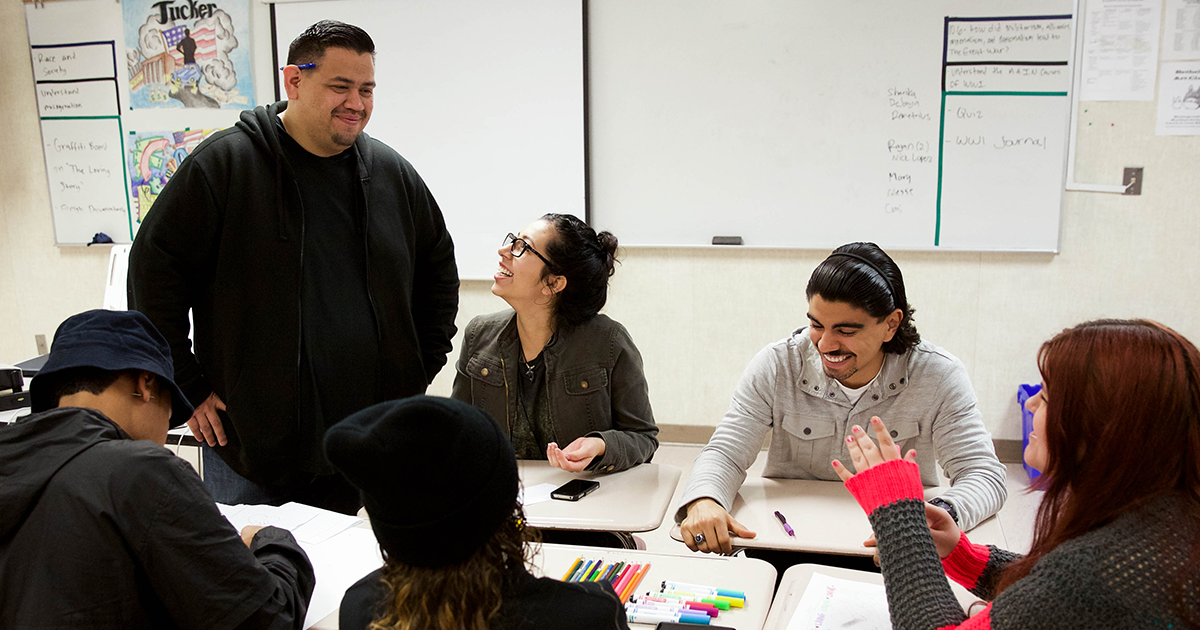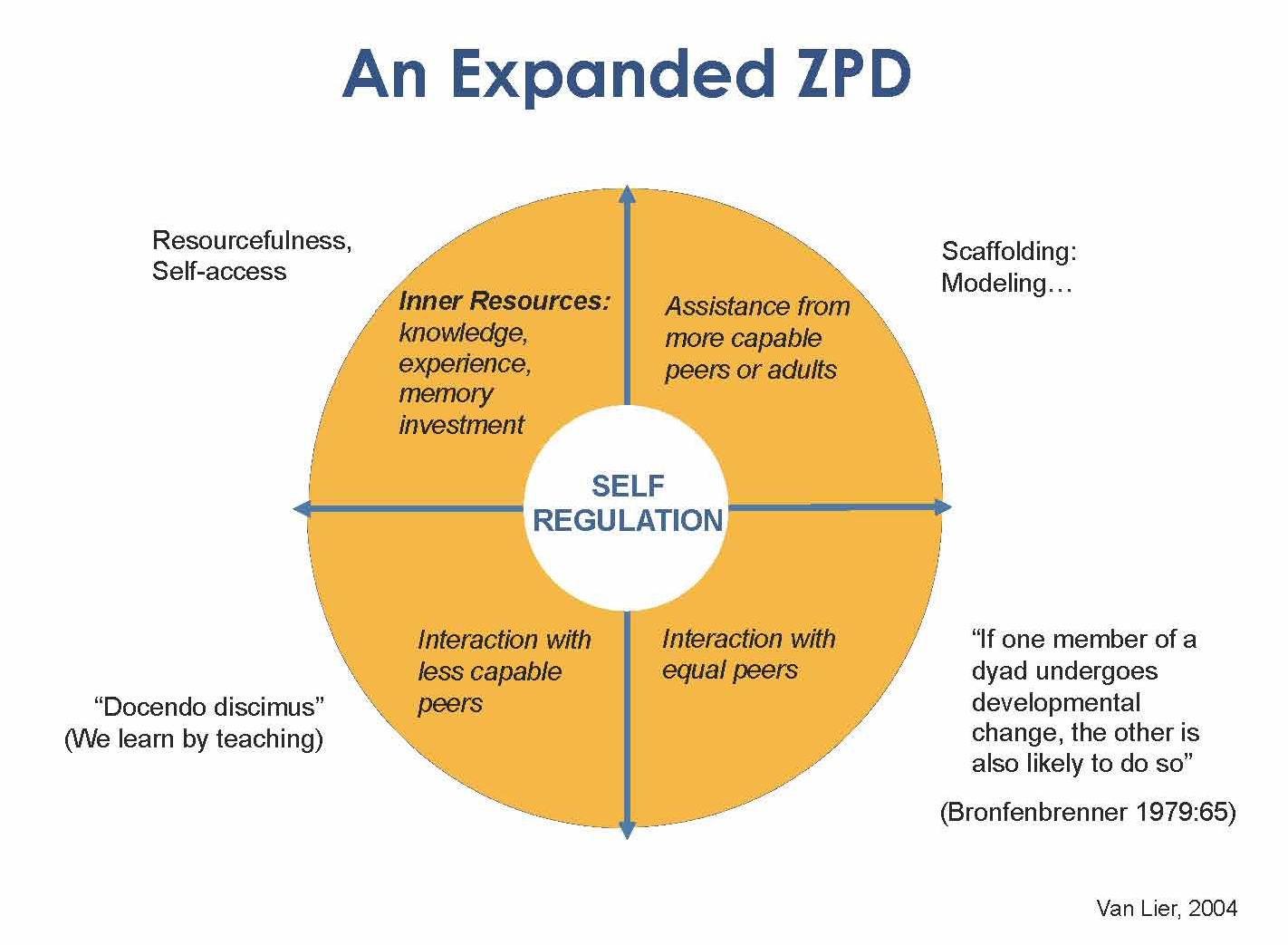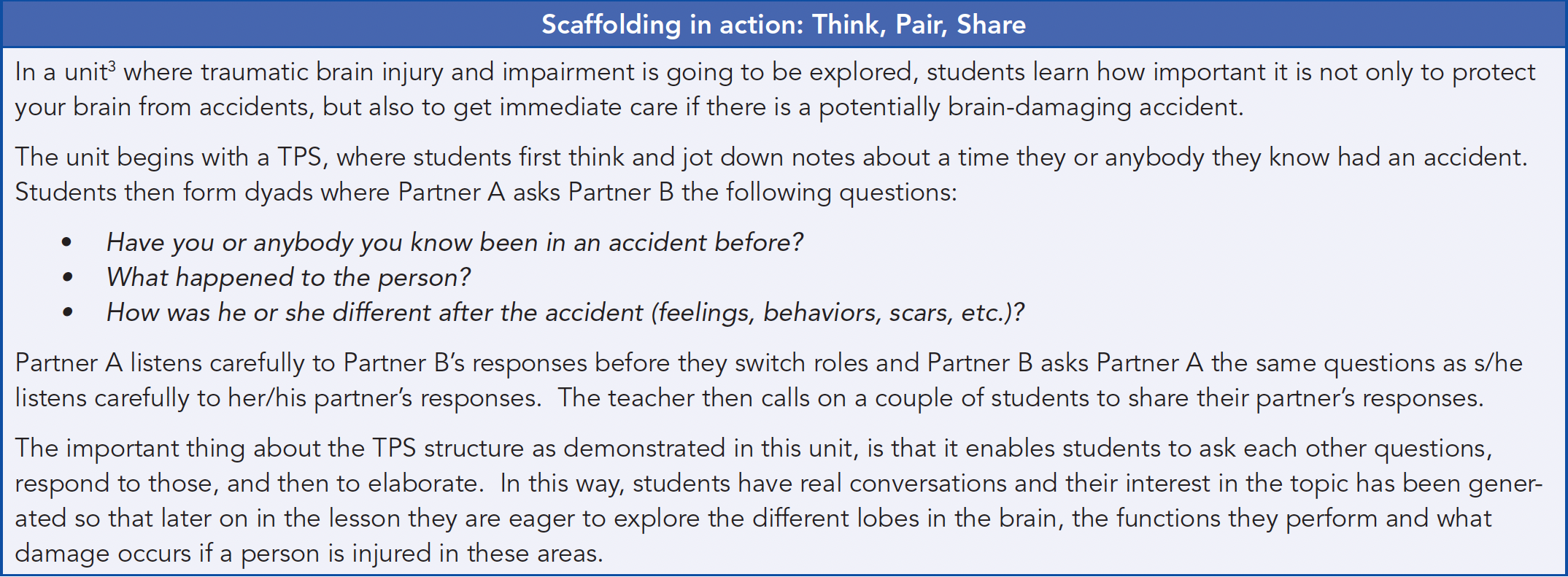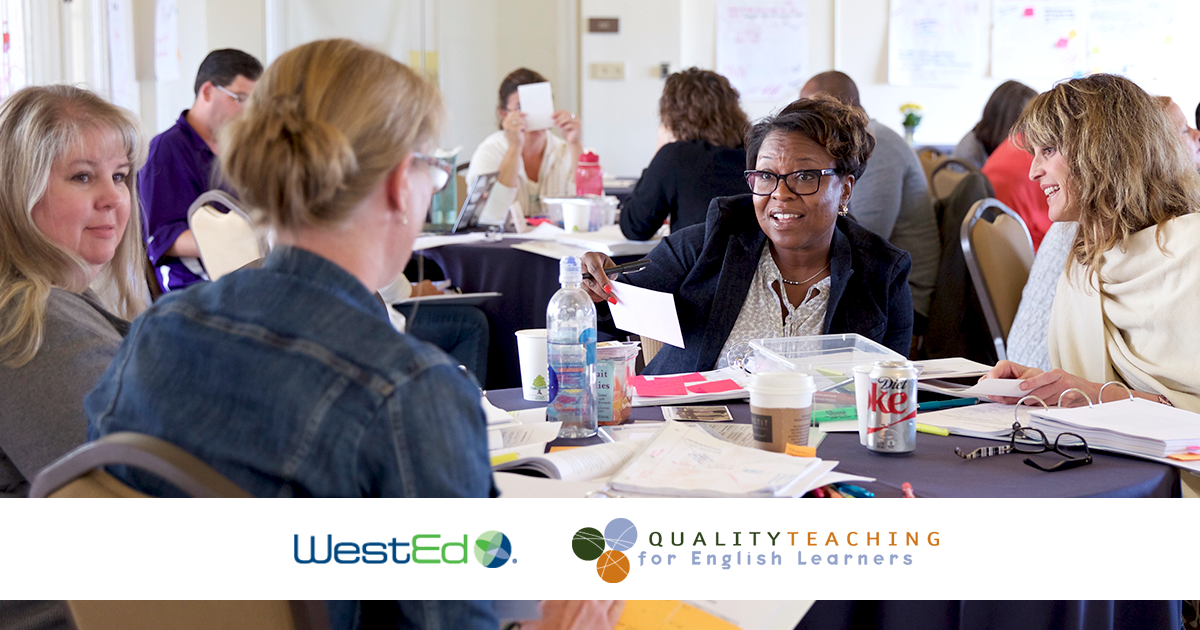Spotlight on English Learners: Zone of Proximal Development—An Affirmative Perspective in Teaching English Learners
Posted on

By Senior Program Associate Elsa Billings and Senior Research Scientist Aída Walqui at WestEd. The Zone of Proximal Development: An Affirmative Perspective in Teaching ELLs brief was written for and published by the New York State Education Department (NYSED) Office of Bilingual Education and World Languages. The brief is adapted and posted here with permission.
What is the Zone of Proximal Development?
The zone of proximal development (ZPD) is perhaps one of the most commonly used terms in the field of education. Yet, as often happens, we use terminology with a limited understanding of the concepts involved. The ZPD was a key construct in Lev Vygotsky’s theory of learning and development (Vygotsky, 1978). Vygotsky defined the ZPD as:
“[T]he distance between the actual developmental level (of the learner) as determined by independent problem solving and the level of potential development as determined through problem solving under adult guidance, or in collaboration with more capable peers” (Vygotsky, 1978, p. 86). Two critical elements in Vygotsky’s definition of ZPD are the notions of potential development of the learner and the role collaboration plays in the learning process.
A Student’s Potential Development
The concept of a learner’s potential development refers to the space beyond a learner’s current capabilities and understandings. It is that which a learner is capable of, but has yet to achieve. In the case of English Learners and Multilingual Learners, the immense potential that they bring to our classrooms is comprised of their intellectual, linguistic, and creative strengths that are waiting to be built upon. Our responsibility as educators is to provide students appropriate learning experiences and support to help them realize their potential development. The goal of instruction is to foster our English Learners’ and Multilingual Learners’ autonomy and their ability to engage in activities that enable them to apply and modify what they have learned to new situations.
This process entails a pedagogical balance of high challenge and high support in which we take a future-oriented perspective of learning. This means that we recognize that, accompanied by deliberate pedagogical supports, learning takes place in advance of the development we wish to see. In this way teaching precedes development. When we view education as future-oriented, we simultaneously build on students’ backgrounds while we are considering their next levels of development and emerging capacity. This space of potential development is the ZPD and it is the space in which learning occurs, thus where teaching needs to be situated. What this means for our English Learners and Multilingual Learners is that we do not have to wait until their English is perfect to engage them in intellectually stimulating and demanding tasks. On the contrary, learning can only occur when it is constructed in advance of development in the ZPD.
Learning as a Social Process
How does this learning in advance of development occur? Collaboration is an essential element of productive work in the ZPD, as Vygotsky viewed learning as a social process. With learning taking place in the ZPD, the area beyond a student’s level of independent skill or knowledge, Vygotsky realized that we learn through our dialogic interaction with others. When students perform in their ZPD for a given task, they are apprenticing and consequently unable to engage in the task on their own. They need appropriate guidance, modeling, and assistance, all of which are provided through collaboration with peers or teachers. Thus, teachers have to deliberately construct these collaborative structures, ensuring that they invite students to participate in worthwhile conceptual and analytical practices while at the same time developing the English necessary to accomplish them. In this way the student moves through their zone of proximal development and ultimately into the space of internalization and autonomy, which is the goal of learning. More than a simple process of partnering students, learning in this “construction” zone takes place through the construction and enactment of invitations to interact in intellectually stimulating tasks. These invitations are premised on in-depth understanding of our students, which requires formatively assessing them to determine where the next learnings should be placed and combined with careful and contingent scaffolding. Scaffolding thus simultaneously considers our students’ current understandings and interests along with their future potential for development.
Scaffolding1
Scaffolding involves both the structural and procedural supports that guide and enable learners to work within their ZPD so that they may develop their full, yet unrealized, potential. The structural element of scaffolding refers to those planned, ritualized structures that surround learning tasks. An example of structural scaffolding is the step-by-step guidelines used in a Think, Pair, Share (TPS) task.2 There are three moments in a TPS task:
- Think: The teacher asks one or two questions for students to consider. In order to see what students are thinking, as well as to provide additional scaffolding as needed, the teacher asks students to record key elements of their answer using words or phrases, but not complete sentences. Depending on the complexity of the questions, the teacher may assign between three and five minutes for students to jot down their ideas. Meanwhile, the teacher circulates around the classroom to monitor and check what students have written. An empty piece of paper may be an indication that the student needs further support from the teacher.
- Pair: Students are asked to form dyads. There are many ways of doing this, depending on time available, the nature of the questions, or even what time of the day it is (classes immediately after lunch may require opportunities for movement).
- Share: Dyads orally share their responses with each other. All students should be ready—if called upon—to present to the class their partner’s responses first, and then their own.
The TPS provides a scaffolded structure for students to orally request ideas from a partner, listen to their peers’ ideas, and ask and respond to questions, thus contributing to and gaining new perspectives on the topic at hand. The result is that both students are enabled to co-construct meaning. Scaffolding structures must maintain a careful balance of providing support to the learner without being so rigid or limited as to stifle the learner. They are simultaneously constant and flexible. For example, within a TPS, the structure remains constant while the focal theme or question of the TPS task is flexible and changes each time. In this way, English Learners and Multilingual Learners do not experience cognitive overload by having to understand and enact a new structure for sharing ideas and can mentally tend to the central theme or question of the TPS task, allowing them to genuinely participate in the task. After participating in a TPS a few times, students become familiar with this collaborative structure for sharing ideas so that it becomes automated. Eventually, the teacher can add flexibility to the TPS structure itself with slight alterations such as including a drawing or a writing option to the steps.
The procedural aspect of scaffolding emerges through the unplanned support that occurs in-the-moment and in response to something new the learner introduces in classroom interactions. The on-the-spot nature of procedural scaffolding makes it contingent on the learner and the particular situation in which it occurs. This means that in addition to continually monitoring students’ understanding, the teacher is also assessing their own structural scaffolds so as to be able to quickly modify them in order to support students’ progression to the ZPD. It is thus through the planned structure together with the contingent, in-the-moment process of scaffolding that the teacher creates both the circumstances and supports that permit students to enter into and engage in their ZPD and that promote their autonomy as learners. We must take care to fully understand that our goal is learner autonomy. Eventually, our students should proceed through their ZPD to self-regulation in which they no longer need the scaffolds we provided earlier. Indeed, if our scaffolded instruction does not develop autonomy, it is not productive work in the ZPD.
Expanded Understandings of the ZPD
Vygotsky’s theory of learning advanced the field’s understanding of the learning process. Since Vygotsky’s initial conceptualization of the ZPD, researchers have expanded to further elaborate upon the collaborative nature of the learning process. This work recognizes that learning is not limited to interactions between the learner and an adult or “more capable” peer (Vygotsky, 1978, p. 86). In addition to expert-novice interactions, the ZPD can also be supported through interactions between:
- Equal peers (peers with the same levels of knowledge) (Donato, 1994 in Walqui & van Lier, 2010). When learners with relatively equal levels of knowledge work together they can create zones of proximal development for each other as their interactions give rise to ideas, which are then shared with peers and which are then further advanced and developed through collaboration.
- Less capable peers (a novice supporting another learner) (van Lier, 1996, 2004 in Walqui & van Lier, 2010). When a novice learner teaches another learner who has slightly less knowledge, the interaction supports both learners working in the zone of proximal development; as the novice articulates, expands, and clarifies ideas, both learners simultaneously are expanding their knowledge.
- Working alone (van Lier, 1996, 2004 in Walqui & van Lier, 2010). Learners can work within their zone of proximal development when they use “learning strategies, inner speech, resources in their environment, and experimentation” that they have internalized (Walqui & van Lier, 2010, p. 31).
The visual below depicts this expanded notion of the ZPD as articulated by van Lier (2004, p. 158). Understanding that learning is a social process that can be facilitated through numerous interactions, and is not limited solely to expert-novice interactions, creates limitless possibilities as we think about how we can best support English Learners and Multilingual Learners in our classrooms through scaffolded interactions with peers and teachers.
The Expanded ZPD and Language Learning
 For many well-intentioned teachers of English Learners and Multilingual Learners, a common misconception exists; this is the notion that English Learners and Multilingual Learners must perfect their English before they are capable of engaging with grade-level content. This misconception leads many teachers to spend critical instructional time focusing on isolated linguistic activities that are “free of content.”
For many well-intentioned teachers of English Learners and Multilingual Learners, a common misconception exists; this is the notion that English Learners and Multilingual Learners must perfect their English before they are capable of engaging with grade-level content. This misconception leads many teachers to spend critical instructional time focusing on isolated linguistic activities that are “free of content.”
Too often English Learners and Multilingual Learners are removed from heterogeneous classrooms and isolated in English as a Second Language or English Language Development courses, rendering students devoid of contact and interaction with English Learners and Multilingual Learners who have better command of English or native English-speaking peers. As a result, they are provided very narrowly focused education in which grammar and vocabulary, not content, are the focus and where language is “curricularized” (Valdés, 2001).
However, what Vygotsky’s and other researchers’ work shows us is that by identifying the skills, knowledge, and practices that are on the edge of development (i.e., the ZPD), teachers can provide targeted support or scaffolds for students to reach the desired level of skill/knowledge and thus move toward autonomy in that area. It is in this space that a teacher’s role is to recognize and integrate the exact pedagogical scaffolds that support students’ ripening of linguistic, conceptual, and/or academic potential. For English Learners and Multilingual Learners to reach their potential, it is essential that we provide them access to content, as well as regular and consistent opportunities to engage with their peers in a heterogeneous classroom setting.
The implications of this understanding are exciting in that it frees teachers from the instructional restraints that come with the belief that English Learners and Multilingual Learners can only learn content that is within or below their language level. Essential to such learning is the deliberate, thoughtful planning and scaffolding of tasks that the teacher provides via structured heterogeneous classroom interactions so that the English Learner or Multilingual Learner is guided through their linguistic and academic zone of proximal development, learning grade-level content and developing language in the process.
Back to the Future
Key to this discussion is the notion that the ZPD is a future-oriented approach that begins from an understanding of students as inherently capable. A future-oriented approach is especially important as we work with our English Learners and Multilingual Learners. Often viewed from a deficit perspective, English Learners and Multilingual Learners can be perceived as fundamentally lacking in the skills and knowledge necessary to complete tasks or access texts. A future-oriented approach instead sees English Learners’ and Multilingual Learners’ future potential and thus presents an affirmative stance that sets them up for success. It is a teacher’s expertise, knowledge, and concomitant pedagogical action that is responsible for making every English Learner’s and Multilingual Learner’s potential a reality. Walqui and van Lier (2010) summarize this future-oriented approach stating:
English language learners, like all students, arrive in our classrooms with immense potential, strengths to build on, and dreams for their future. It is our job as education professionals to help them realize that potential and to provide them with the right learning opportunities so that they can address rigorous academic content in a language they have yet to master. (p. 1)
We hope you found the ideas in this blog post informative and useful. Download other briefs in this series produced by the New York State Education Department:
- Quality Education for English Learners and Multilingual Learners: Why We Need It and How We Can Achieve It
- Quality Student Interactions: Why Are They Crucial to Language Learning and How Can We Support Them?
- De-Mystifying Complex Texts: What are “Complex” Texts and How Can We Ensure English Learners and Multilingual Learners Can Access Them?
- Dispelling the Myth of “English Only”: Understanding the Importance of the First Language in Second Language Learning
Aída Walqui directs the National Research and Development Center for Improving the Education of English Learners in Secondary Schools at WestEd, where she started one of the agency’s signature programs, the Quality Teaching for English Learners (QTEL) initiative. Elsa Billings works closely with educators at the school, district, and state levels to improve education for English Learners and Multilingual Learners.
Footnotes
1 For more information on scaffolding for English Learners and Multilingual Learners, please refer to the New York City Department of Education brief, Scaffolding, by Walqui and Strom.
2 The TPS is one of the most misunderstood and mispracticed tasks.
3 The Brain Lesson (WestEd, 2008) comes from a secondary level unit that uses personal recounts to illustrate cause and effect of traumatic brain injuries and disease.
Register for QTEL Summer Institutes
Quality Teaching for English Learners (QTEL) Summer Institutes develop educator expertise to provide high-challenge, high-support instruction that helps English Learners succeed in a rapidly changing world.


